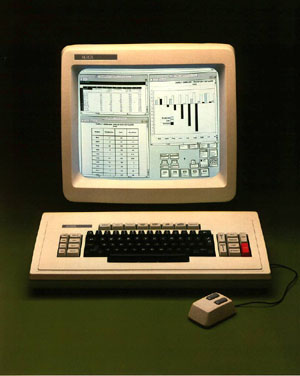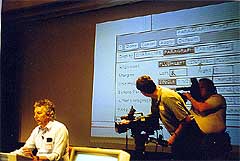
 |
Announcement

Bay Area
Computer History Perspectives and The Computer
Museum History Center present:

"The
final live demonstration of the Xerox 'Star' computer, 1981"
Unquestionably, one of the major design innovations of this century has been the Graphical User Interface for computers, with its desktop, icons, pop-up and pull-down menus and ubiquitous windows. The explosion of computer usage in the last decade has in large part been made possible by this simpler and more direct method of user interaction.
Though over 100 million people around the world are now using GUI's, few outside of the Human/Computer Interaction field are aware of the history of its design.
The first GUI ever developed was the work of Dr. Douglas Englebart, a researcher at SRI in the 1960s. His visionary and pioneering design and prototypes succeeded in producing the world's first screen-based windows, cursor-selectable pop-up menus, as well as the mouse with which to interact with them.
Though these innovations were truly revolutionary, it was not until a decade later that researchers at the Xerox Palo Alto Research Center (PARC) began systematically applying these ideas in personal computers.
During the 1970s, PARC produced the first personal computer to have a bitmapped display and to use overlapping windows (the "Alto"), the first laser printers, the first Ethernet local area network, and object-oriented programming languages such as Smalltalk.
Seventeen years ago, in 1981, these ideas came together in the Xerox 8010 "Star" Information System. This was a commercial personal computer designed for office workers and built by Xerox's System Development Division. It incorporated features that today define personal computers: a bitmapped display, mouse, windows, local hard disk, network connectivity, and laser printing. In addition, Star invented and introduced the first graphical user interface, with the first icons, desktop metaphor, dialog boxes, universal commands, and a "point and click" style of interaction now known as "direct manipulation." It was the first commercial object-oriented computer interface.
As revolutionary as these software ideas were, the hardware was equally innovative. When the Star project was begun in 1975, only rudimentary microprocessors existed such as Intel's 8008 and MOS Technology's 6502.
To obtain the speed needed for the graphical user interface and to enable a very cost-effective machine for the time (1/10 the cost of a nearly-equivalent performance PDP-11), Star used four 2901 bit-sliced processors to implement the Mesa language and to control I/O and the 10-mbps Ethernet. Without the advantage of hardware interrupts, its designers supported an event-driven interface by creating a nonpreemptive multitasking architecture. They designed the first commercial Ethernet protocols and developed a suite of network services including a world-wide naming architecture that anticipated today's URL's.
Star had a profound effect on the personal computer industry. Today all personal computers and many workstations incorporate its ideas. It is not farfetched to state that Star was a motivating factor in the formation of the computer-human interaction field and ACM's SIGCHI organization (which was formed in 1982, the year after Star came out).
Yet few people have actually seen a Star computer. We will remedy that in this presentation. The head of the Star project and several of its inventors will give a one final demonstration of Star and use it to illustrate its design principles. This may be the last time it gets demoed, as the hardware has begun failing due to its age. Don't miss this opportunity to witness an important step in the history of computing and user interface design.
The Speakers:
Dr. David E. Liddle is co-founder, president and CEO of Interval Research Corporation, a high-technology research lab studying technologies that will be meaningful to people in the future. Interval performs research and advanced development in more than 20 technology areas, including network cultures, interactive entertainment, fashionable technology and signal computation.
During and after his education (B.S., E.E., University of Michigan; Ph.D, Computer Science, University of Toledo, Ohio), Liddle has spent his professional career developing technologies for interaction and communication between people and computers. He worked for ten years at the Xerox Palo Alto Research Center and the Xerox Information Products Group where he was responsible for the first commercial implementation of the Graphical User Interface and local area networking. He then founded Metaphor Computer Systems which was acquired by IBM in 1991. In 1992, he co-founded Interval Research with Paul Allen.
Liddle is a consulting professor of Computer Science at Stanford University. He is chairman of the board of trustees of the Santa Fe Institute. He has served as a director of several companies. He was honored as a distinguished alumnus from the University of Michigan, as a member of the advisory committee of the school of Engineering at Stanford University and as a Senior Fellow of the Royal College of Art.
Dr. David Canfield Smith received a B.A. in mathematics from Oberlin College in 1967 and a Ph.D. in computer science from Stanford University in 1975. His Ph.D. thesis contained two new ideas: icons and programming by demonstration. After a brief stop at SRI in Doug Englebart's Augmentation Research Center, Dr. Smith joined the Xerox Corporation's "Star" computer project in Palo Alto, remaining with it for seven years.
He was one of the principle designers of the Star user interface, inventing for it the concepts of icons (from his Ph.D. work), the desktop metaphor, dialog boxes, and generic commands. After joining and/or founding three start-up companies in five years, Dr. Smith joined Apple Computer in 1988. At Apple he worked on a variety of software projects for future computers, including educational software with Alan Kay. This work culminated in a new approach to programming by children, called "Cocoa." Today he is in a start-up company that is turning Cocoa into a product. The unifying goal behind Dr. Smith's work for the past twenty years has been to make computers more accessible to ordinary people.
Dr. Robert L. Belleville joined Doug Englebart's pioneering laboratory at SRI after completing his Ph.D in 1974. At Xerox he developed both the 8010 Star and 8086 based network pc called Cub. Called by Steve Jobs in 1982 he directed the development of the original Macintosh, Laserwriter and AppleTalk network. Until 1997 he investigated information access technology at SGI. He is currently a clock maker in Los Altos.
Robert Garner joined Xerox in 1977 and co-designed the Xerox STAR Professional Workstation, responsible for the CPU and Ethernet interface hardware. In 1984 at Sun Microsystems, he was co-architect of Sun's SPARC RISC architecture and co-designed the Sun-4/200, Sun's first SPARC workstation. More recently he was a senior manager on the UltraSPARC-I microprocessor and then director of Java media microprocessors.
Dave Curbow joined the Xerox Star development team in 1983 as a software engineer and later became an HI designer. In 1990 he moved to Apple where he worked as an HI designer and researcher until 1997. During this time, Dave Curbow and Dave Smith were two of the principle HI designers of OpenDoc -- which brought some of Star's pioneering features to today's PCs. Today Dave is a member of the SunSoft Science Office. Dave has a garage full of Xerox hardware that was the basis for the first "last" Star demo at the CHI '98 conference.
See Also:
The Digibarn's coverage of the final public demo of the Star
View videos of the entire Final Public Star Demo here (Quicktime streams)
The Digibarn's extensive collection of Xerox computers and other artifactsBruce Damer's history of the Xerox Alto, Star, Elixir desktops
Please
send site comments to
our Webmaster.
Please see our notices
about the content of this site and its usage.
(cc) 1998- Digibarn Computer Museum,
some rights reserved under this Creative Commons license.